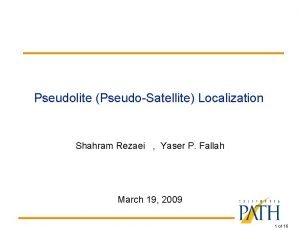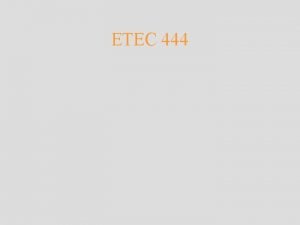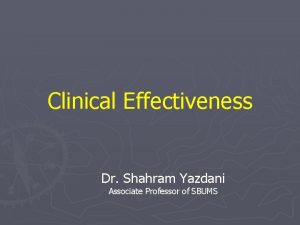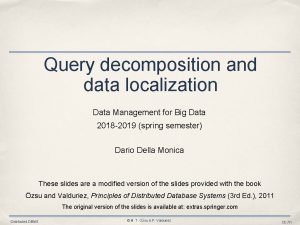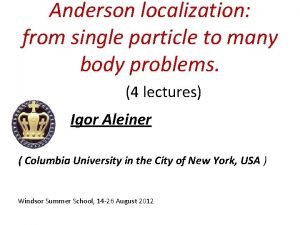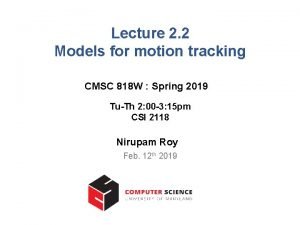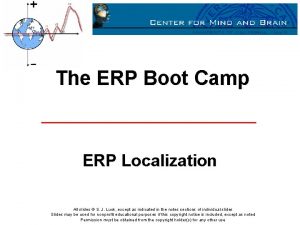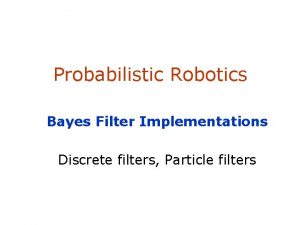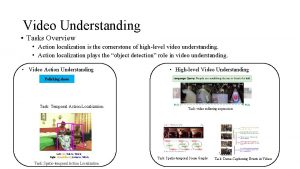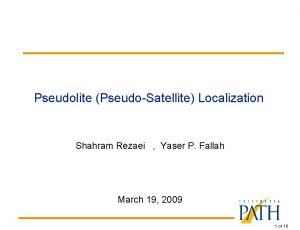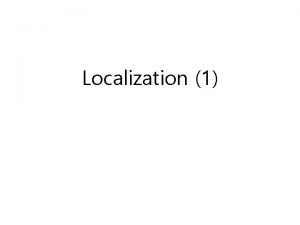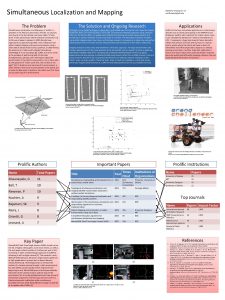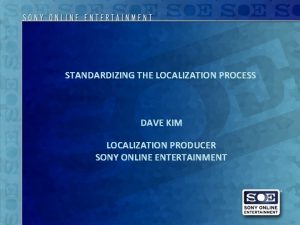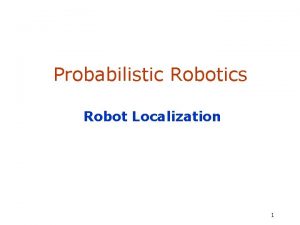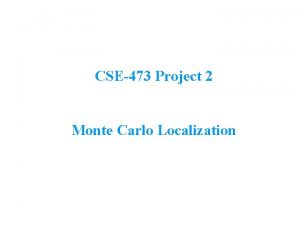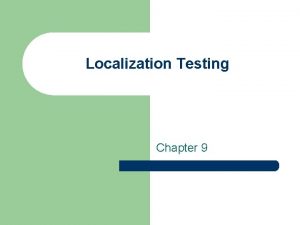Pseudolite PseudoSatellite Localization Shahram Rezaei Yaser P Fallah












![Pseudolite Signals (no standard exists) [1] J. Barnes, C. Rizos, et. al. , “High Pseudolite Signals (no standard exists) [1] J. Barnes, C. Rizos, et. al. , “High](https://slidetodoc.com/presentation_image_h/cd4474f7b1c3349ee3706611e1d38343/image-13.jpg)

![Clock: Time. Loc Technique The Time-Loc procedure for two Locata. Lites (transmitters) [1] Synchronization Clock: Time. Loc Technique The Time-Loc procedure for two Locata. Lites (transmitters) [1] Synchronization](https://slidetodoc.com/presentation_image_h/cd4474f7b1c3349ee3706611e1d38343/image-15.jpg)
![Initialization Issue (1/2): What Locata does LINE: Locata Integrated Navigation Engine [1] And I Initialization Issue (1/2): What Locata does LINE: Locata Integrated Navigation Engine [1] And I](https://slidetodoc.com/presentation_image_h/cd4474f7b1c3349ee3706611e1d38343/image-16.jpg)
![Initialization Issue (2/2): In case of vehicle? ! [1] [1] J. Barnes, C. Rizos, Initialization Issue (2/2): In case of vehicle? ! [1] [1] J. Barnes, C. Rizos,](https://slidetodoc.com/presentation_image_h/cd4474f7b1c3349ee3706611e1d38343/image-17.jpg)







- Slides: 24

Pseudolite (Pseudo-Satellite) Localization Shahram Rezaei , Yaser P. Fallah March 19, 2009 1 of 16

Topics 1. Pseudolite Concept 2. Pseudolite Literature 3. How GPS Works? (GPS, D-GPS, A-GPS) 4. Carrier-Phase GPS 5. Pseudolite signals 6. Pseudolite Clock Synchronization 7. Pseudolite Initialization Issue 8. Conclusion, Open Problems 2 of 16

Pseudolite Concept • • One receiver (user) with unknown location. N stationary transmitters with known locations. Pseudolite has been the testing method for GPS in early 70’s. Pseudolite is the testing method for Galileo. (xr , yr , zr)=? RX Y TX 1 TX 2 TX 3 (x 2 , y 2 , z 2) (x 3 , y 3 , z 3) (x 1 , y 1 , z 1) Z X 3 of 16

Literature 1) Vlad Badea, Rikard Eriksson, “Indoor Navigation with Pseudolite (Fake GPS Satellite)”, MSc Dissertation, University of Linköping, Sweden, 2005. 2) J Barnes, C. Rizos, et. al. , “High accuracy positioning using Locata’s next generation technology, ”. 18 th Int. Tech. Meeting of the Satellite Division of the U. S. Institute of Navigation, Long Beach, California, pp. 13 -16, 2005. 3) J. Barnes, C. Rizos, J. Wang , et. al. , “High precision indoor and outdoor positioning using Locata. Net”, Journal of Global Positioning Systems, Vol. 2, No. 2, pp. 73 -82, 2004. 4) T. Ford J. Neumann, N. Tos, et. al. , “HAPPI-a High Accuracy Pseudolite/GPS Positioning Integration”, 9 th Int. Tech. Meeting of the Satellite Division of the U. S. Inst. of Navigation, Kansas City, Missouri, pp. 1719 -1728, 1996. 5) Anis Drira, “GPS Navigation for Outdoor and Indoor Environments”, MSc Dissertation, The University of Tennessee, Knoxville, May 2006. 6) J. Raquet, G. Lachapelle, et. al. , “Development and Testing of a Mobile Pseudolite Concept for Precise Positioning”, Proceedings of the Institute of Navigation GPS-95 Conference, Palm Springs, CA, pp. 149 -165, 1995. 7) Changdon Kee, Doohee Yun, Haeyoung Jun, “Precise Calibration Method of Pseudolite Positions in Indoor Navigation Systems”, Computers and Mathematics with Applications, Vol. 46, No. 10, pp. 1711 -1724, 2003. 8) J. Barns, Joel Van Cranenbroeck, C. Rizos, et. al. , “Long Term Performance Analysis of a New Ground-Transceiver Positioning Network (Locata. Net) for Structural Deformation Monitoring Applications”, FIG Working Iek, Strategic Integration of Surveying Services, pp. 13 -17, May 2007, Hong Kong. 9) www. gmat. unsw. edu. au/snap/about/publications_year. html 4 of 16

3. How GPS Works (GPS Signals) There are 31 operational GPS satellites right now. Entirely available to public Most receivers can only track L 1 frequency, so called single-frequency receivers. Dual-frequency receivers can track both L 1 and L 2 frequencies. Most RTK receivers are dual frequency receivers. The L 2 frequency is not entirely available to the general public but there are techniques to extract code and carrier from the L 2 signal. 5 of 16

How GPS works? (GPS, AGPS, DGPS) Distance Measurement (1/2) Approximated or ignored. Satellite sends models for this. Unknown 1 Approximated. In DGPS, the base station sends this info. Approximated or ignored. 6 of 16

How GPS works (GPS, AGPS, DGPS) Distance Measurement (2/2) P sr= c * dt c [speed of light] dt [time of flight of C/A signal] Unknown 2 AGPS sends this info. GPS can also decode from sky, takes >30 sec and need high SNR. Unknown 3 Unknown 4 Thus, there are 4 unknowns, need measurements from 4 satellites to solve. 7 of 16

Using PRN code for ranging • A GPS receiver will generate the same PRN code, then delays it to aligns it with the received satellite signal, • distance to satellite is = delay * C (assuming no timing offset, that the satellite and receiver were aligned initially) 8 of 16

Carrier-Phase GPS (1/2) • Finding travel time using raw carrier signal is more accurate than using C/A code. o L 1 carrier frequency = 1. 575 GHz, λ = 19 cm o C/A frequency= 1. 024 MHz λ = 293 m • This method is counting the exact number of carrier cycles between the satellite and the receiver. • The problem is phase ambiguity. The trick with "carrier-phase GPS" is to use code-phase techniques to get close. If the code measurement can be made accurate to say, a meter, then we only have a few wavelengths of carrier to consider as we try to determine which cycle really marks the edge of our timing pulse [1] http: //www. trimble. com/gps/dgps-advanced 4. shtml 9 of 16

Carrier Phase Tracking Initial tracking of carrier phase takes time (up to 10 minutes) Cycle slip is possible 10 of 16

Carrier-Phase GPS (2/2) - + The main challenge 11 of 16

Pseudolites • The same concepts as in GPS – Ionospheric error does not exist – Tropospheric error is negligible – Multipath effects remain unchanged – No need for accurate clocks • RTK concept is applicable too • 10 MHZ chipping rate -> better accuracy using C/A GPS Error Source Range Error (m) PL Range Error (m) Satellite Orbital (only GPS) and Transmitter 1 m 1 m Tropospheric 1 m ~0 Ionospheric 10 m 0 Receiver Clock Error 1 m 1 m Multipath 10 m Clock Error 12 of 16
![Pseudolite Signals no standard exists 1 J Barnes C Rizos et al High Pseudolite Signals (no standard exists) [1] J. Barnes, C. Rizos, et. al. , “High](https://slidetodoc.com/presentation_image_h/cd4474f7b1c3349ee3706611e1d38343/image-13.jpg)
Pseudolite Signals (no standard exists) [1] J. Barnes, C. Rizos, et. al. , “High accuracy positioning using Locata’s next generation technology, ”. 18 th Int. Tech. Meeting of the Satellite Division of the U. S. Institute of Navigation, Long Beach, California, pp. 13 -16, 2005. 13 of 16

Clock: Precise Timing • Precise timing is critical due to speed of light: 1 nano-sec time error 0. 3 m error • GPS satellites use atomic clocks: very accurate , but expensive ($100 K or more). • Pseudolite clocks (both transmitter and receiver) are low cost TCXO (Temperature Compensated Cristal Oscillator). • Several methods have been proposed for clock synchronization of pseudolites to achieve cm accuracy: • Locata uses its own technology: Time. Loc (next slide) Time. Loc removes relative clock error between transmitters. 14 of 16
![Clock Time Loc Technique The TimeLoc procedure for two Locata Lites transmitters 1 Synchronization Clock: Time. Loc Technique The Time-Loc procedure for two Locata. Lites (transmitters) [1] Synchronization](https://slidetodoc.com/presentation_image_h/cd4474f7b1c3349ee3706611e1d38343/image-15.jpg)
Clock: Time. Loc Technique The Time-Loc procedure for two Locata. Lites (transmitters) [1] Synchronization is maintained, to if one clock drifts, the others can compensate (assuming PLs are not moving) [1] J. Barnes, C. Rizos, J. Wang , et. al. , “High precision indoor and outdoor positioning using Locata. Net”, Journal of Global Positioning Systems, Vol. 2, No. 2, pp. 73 -82, 2004. 15 of 16
![Initialization Issue 12 What Locata does LINE Locata Integrated Navigation Engine 1 And I Initialization Issue (1/2): What Locata does LINE: Locata Integrated Navigation Engine [1] And I](https://slidetodoc.com/presentation_image_h/cd4474f7b1c3349ee3706611e1d38343/image-16.jpg)
Initialization Issue (1/2): What Locata does LINE: Locata Integrated Navigation Engine [1] And I could not find any thing confirming that it is available now. [1] J. Barnes, C. Rizos, et. al. , “High accuracy positioning using Locata’s next generation technology, ”. 18 th Int. Tech. Meeting of the Satellite Division of the U. S. Institute of Navigation, Long Beach, California, pp. 13 -16, 2005. 16 of 16
![Initialization Issue 22 In case of vehicle 1 1 J Barnes C Rizos Initialization Issue (2/2): In case of vehicle? ! [1] [1] J. Barnes, C. Rizos,](https://slidetodoc.com/presentation_image_h/cd4474f7b1c3349ee3706611e1d38343/image-17.jpg)
Initialization Issue (2/2): In case of vehicle? ! [1] [1] J. Barnes, C. Rizos, et. al. , “High accuracy positioning using Locata’s next generation technology, ”. 18 th Int. Tech. Meeting of the Satellite Division of the U. S. Institute of Navigation, Long Beach, California, pp. 13 -16, 2005. 17 of 16

Multipath Fading • Locata’s solution to Signal Multipath Fading – Spatial: via multiple antenna elements physically separated in space – Multipath fading addressed at macro-level: if fading results in no-signal, use a different antenna, – Increasing the number of antennas increases the chance of receiving the PL signal; assuming fading effects are independent at different antennas 18 of 16

Conclusion, Open Problems 1. There are two companies that make Pseudolite: • Locata (www. locatacorp. com ), based in NSW, Austrlia • Novariant (www. novariant. com), based in Fremont, CA Both solutions have been designed for local area applications, such as construction, mining, and agricultural. 2. To use Pseudolite for vehicular applications, the initialization issue must be first addressed. Dual frequency receiver is a need for this, but not sure why Locata has not been successful doing it. 3. SNAP (Satellite Navigation and Positioning lab) which is research wing of Locata at University of NSW in Australia has been very inactive in Pseudolite field; they don’t have publication in this field after 2007. Recent publications are focused on low-cost GPS receivers and their integration with INS and other sensors. 19 of 16

Suggested Topics for Further Investigation • Dual Frequency Phase Ambiguity Resolution • Multipath mitigation for Pseudolites 20 of 16

Thank you! Any question? Ask Yaser Thanks Yaser. 21 of 16

Difference between DGPS & RTK from Trimble website • • It can be difficult to distinguish between RTK and DGPS. Here's a quick review the differences: To get initialized, RTK needs a minimum of five satellites. After that it can operate with four. DGPS needs a minimum of three, though at least four are required for sub-meter accuracy. For RTK, you need a dual frequency GPS receiver. Single frequency receivers are sufficient for DGPS. For RTK, your GPS receiver must be capable of On-the-Fly initialization (obtaining centimeter accuracy while moving). For DGPS, this isn't necessary. With RTK, it takes one minute to initialize. DGPS receivers initialize immediately. You can expect accuracy of a few centimeters in all three dimensions using RTK. With DGPS, you can achieve submeter accuracy in horizontal position only. To obtain GPS corrections for RTK, you need your own base station that is no more than ten kilometers from the field you are working in. For DGPS, you can use your own base station, a correction service provider, or make use of the free radio beacon broadcasts in many regions. 22 of 16

GPS Augmentation methods 23 of 16

RTK-GPS • • DGPS : correction information is sent by a base station. RTK is essentially a DGPS method, enhanced with carrier phase tracking In general receivers are able to align the signals to about 1% of one bitwidth – coarse-acquisition (C/A) code bit width ~1μs, receiver accurate to 0. 01μs, or about 3 meters – If signal carrier is used for ranging (1 ns), and 1% precision is possible (. 01 ns), receiver accuracy is 3 mm. One wavelength accuracy: 19 cm. In practice, – RTK systems use a base station receiver & a number of mobile units, within a 10 Km range. – BS re-broadcasts the phase of the carrier that it measured; the mobile units compare their own phase measurements with the ones received from BS – This allows the units to calculate their relative position to millimeters, although their absolute position is accurate only to the same accuracy as the position of the base station. 24 of 16
 Shahd abumostafa
Shahd abumostafa Dış ticaret işlemleri yönetimi yaser gürsoy
Dış ticaret işlemleri yönetimi yaser gürsoy Ali csulb
Ali csulb Ali rezaei csulb
Ali rezaei csulb Dr. shahram yazdani
Dr. shahram yazdani Dr. shahram yazdani
Dr. shahram yazdani Dr sharam yazdani
Dr sharam yazdani Dr shahram yazdani
Dr shahram yazdani Dr sharam yazdani
Dr sharam yazdani Games language
Games language Buccal object rule
Buccal object rule Data localization in distributed database
Data localization in distributed database Localization of function ib psychology
Localization of function ib psychology Felix sasaki
Felix sasaki Anderson localization lecture notes
Anderson localization lecture notes Tracking cmsc
Tracking cmsc Voice localization using nearby wall reflections
Voice localization using nearby wall reflections Lqa quality assurance
Lqa quality assurance Cump erp
Cump erp Markov localization
Markov localization Monte carlo localization for mobile robots
Monte carlo localization for mobile robots Discrete bayes filter
Discrete bayes filter Action localization
Action localization Dnn roadmap
Dnn roadmap Difference between localization and contextualization
Difference between localization and contextualization
